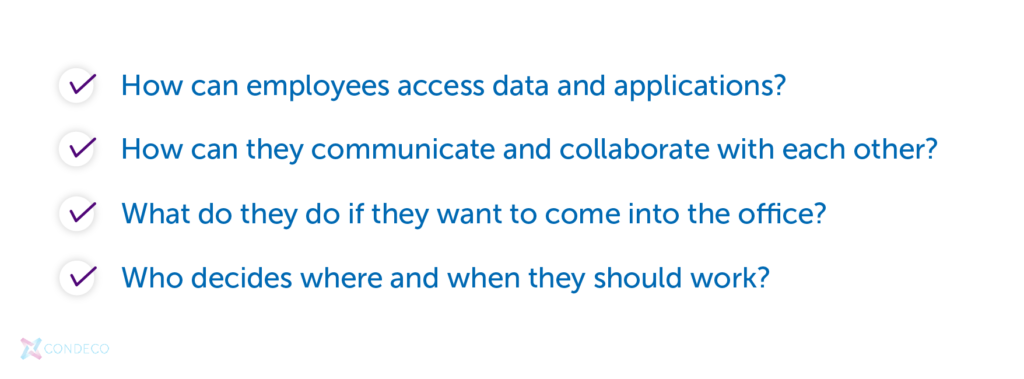
If the last two years have taught us all anything, it’s that there’s much more to flexible work than giving employees a laptop and telling them they can work from home two days a week.
There’s so much more that must be considered so that a business can still run smoothly, while still affording employees the flexibility that they want. There are pressing questions that need answering: how can employees access data and applications? How can they communicate and collaborate with each other? What do they do if they want to come into the office? Who decides where and when they should work?

While these answers will vary from one organization to another, the common theme that all businesses will find is that technology is vitally important to solving all these challenges. In this blog post, we’ll explore five important areas of flexible work technology, and how they can help you strike the right balance in your flexible future.
The cloud

The importance of the cloud for flexible work almost goes without saying, but it can’t be overlooked. Obviously, it provides remote access to all the data and applications employees need to do their jobs, wherever they’re working and whatever type of device they’re using. But just as importantly, the cloud is the enabler for all the solutions and systems that make flexible work possible. If an employee wants to book a meeting room in the office, for example, they need to be able to do so quickly, easily and independently, without having to call or email a facilities team. Only a cloud-based solution gives them this capability, wherever they’re working.
Mobile apps
For employees, when a need for a workspace suddenly arises, mobile apps help you secure the spaces you need just as quickly. With a few taps, you can book a workstation of a meeting room, along with other areas like parking, lockers, quiet spaces, breakout zones. This means that wherever you are, at any point you are in control of your daily schedule. You can see all your bookings in list form, find booked workspaces on a floor plan, and make changes or cancellations to bookings, all to suit you!
Scheduling

The way technology supports employee scheduling isn’t so much about them keeping their own working lives organized: it’s so other employees can see what they’re doing. This is vitally important for enabling easy collaboration, as co-workers need to be able to find out who is working where and when, and when they’re available, so that they can organize meetings that are mutually convenient. That way, meeting organizers will know who is in the office and can take part in person, and who is working at home and will take part virtually. Equipped with this information, accessed through a scheduling platform, they can easily put together everything required for an efficient and effective meeting.
Workspace management
For employees to feel that they’re getting the most out of flexible work, they need to feel that they’re getting the best of both worlds: that they can work in environments that suit them, wherever they’re working. That means that when they travel into the office, they need to be 100% certain that the workspace they want to use suits their needs and will be available for them.

To get that certainty, they need to book spaces in advance, and that’s where a workspace management solution comes in. Through the solution, accessible on any device, they can search for available spaces, check its attributes to ensure it meets their needs, and reserve it for the time they need it for.
Integrated systems

There are so many different facets to flexible work technology that there are huge efficiencies to be found by joining the dots together through integration. This doesn’t just benefit employees, but other departments, too. For example, an integrated workspace management and scheduling solution can be overseen by the IT team, who can monitor bookings and usage, and use analytics to recommend changes to workspace layouts as required. Another example is a catering department, who can automatically receive requests for food and drinks as meetings are booked, giving them full information on what is required for whom, when and where.
Information screens
This level of integration can then feed through to the office environment itself, using information to improve the experience for employees and visitors alike. Desk and meeting room screens can be installed, displaying up-to-date information on upcoming reservations, giving clarity to everyone in the building and ensuring that those who reserve spaces gain access to them. Additionally, wayfinding information can be displayed throughout buildings, helping internal and external attendees easily make their way to their designated meeting room at the appointed time.



